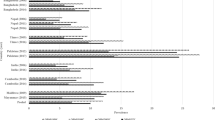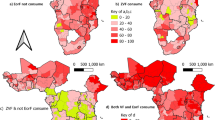Abstract
Objectives:
To assess household food insecurity and dietary diversity as correlates of maternal and child anthropometric status and anemia in rural Cambodia.
Methods:
Trained interviewers administered a survey to 900 households in four rural districts of Prey Veng, Cambodia. The Household Food Insecurity Access Scale (HFIAS) and Household Dietary Diversity Score (HDDS) were used to assess household food insecurity and dietary diversity. The height, weight and hemoglobin concentration of the mother and youngest child under 5 years in each household were measured. Multivariate logistic regression models were constructed to assess the association between household food insecurity and dietary diversity, and child stunting and wasting, maternal thinness, maternal and child anemia.
Results:
The mean (s.d.) HFIAS and HDDS scores were 5.3 (3.9) and 4.7 (1.6), respectively. The respective prevalences of mild, moderate and severe food insecurity were 33, 37 and 12%. Maternal thinness, child stunting and child wasting were present in 14.6, 25.4 and 8.1% of respondents, respectively. The risk of maternal thinness, but not child stunting or wasting, increased as the severity of household food insecurity increased. Household food insecurity was also positively associated with maternal, but not child, anemia. Household dietary diversity status was not significantly associated with any of the outcomes we assessed.
Conclusions:
Efforts to improve household food security are important as a means of promoting maternal nutritional status; however, additional research is needed to better understand the role of other factors that are driving the burden of child undernutrition in Cambodia.
This is a preview of subscription content, access via your institution
Access options
Subscribe to this journal
Receive 12 print issues and online access
$259.00 per year
only $21.58 per issue
Buy this article
- Purchase on Springer Link
- Instant access to full article PDF
Prices may be subject to local taxes which are calculated during checkout

Similar content being viewed by others
References
National Institute of Statistics, Directorate General of Health, ICF Macro. Cambodia Demographic and Health Survey 2010. Phnom Penh, Cambodia; Calverton, Maryland, USA: ICF Macro 2011.
Black RE, Victora RG, Walker SP, Bhutta ZA, Christian P, de Onis M et al. Maternal and child undernutrition and overweight in low- and middle-income countries. Lancet 2013; 382: 427–451.
UNICEF. Improving Child Nutrition: The Achievable Imperative for Global Progress. New York: UNICEF, 2013.
Saha KK, Frongillo EA, Alam DS, Arifeen SE, Persson LA, Ramsmussen KM et al. Household food security is associated with growth of infants and young children in rural Bangladesh. Public Health Nutr 2009; 12: 155–162.
Rah JH, Akhter N, Semba RD, de Pee S, Bloem MW, Campbell AA et al. Low dietary diversity is a predictor of child stunting in rural Bangladesh. Eur J Clin Nutr 2010; 64: 1393–1398.
Osei A, Pandey P, Spiro D, Nielson J, Shrestha R, Talukder Z et al. Household food insecurity and nutritional status of children aged 6 to 23 months in Kailali District of Nepal. Food Nutr Bull 2010; 31: 483–494.
Coates J, Swindale A, Bilinsky A . Household Food Insecurity Access Scale (HFIAS) for the Measurement of Household Food Access: Indicator Guide (v3). Food and Nutrition Technical Assistance Project, Academy for Educational Development: Washington, DC, 2006.
Swindale A, Bilinsky A . Household Dietary Diversity Score (HDDS) for Measurement of Household Food Access: Indicator Guide (v2). Food and Nutrition Technical Assistance Project, Academy for Educational Development: Washington, DC, 2006.
Cogill B . Anthropometric Indicators Measurement Guide. Food and Nutrition Technical Assistance Project, Academy for Education Development: Washington, DC, 2003.
Ali D, Saha KK, Nguyen PH, Diressie MT, Ruel MT, Menon P et al. Household food insecurity is associated with higher child undernutrition in Bangladesh, Ethiopia, and Vietnam, but the effect is not mediated by child dietary diversity. J Nutr 2013; 143: 2015–2021.
Hackett M, Melgar-Quinonez H, Alvarez MC . Household food insecurity associated with stunting and underweight among preschool children in Antioquia, Colombia. Rev Panam Salud Publica/Pan Am J Public Health 2009; 25: 506–509.
Pasricha SR, Black J, Muthayya S, Shet A, Bhat V, Nagaraj S et al. Determinants of anemia among young children in rural India. Pediatrics 2010; 126: e140.
Nisar R, Anwar S, Nisar S . Food security as determinant of anemia at household level in Nepal. J Food Security 2013; 1: 27–29.
Quisumbing AR, Maluccio JA . Intrahousehold allocation and gender relations: new empirical evidence from four developing countries. FCND discussion paper no. 84. International Food Policy Research Institute: Washington, DC, 2000.
Olson CM . Nutrition and health outcomes associated with food insecurity and hunger. J Nutr 1999; 129: 521S–524S.
Velasquez-Melendez G, Schlussel MM, Brito AS, Silva AAM, Lopes-Filho JD, Kac G et al. Mild but not light or severe food insecurity is associated with obesity among Brazilian women. J Nutr 2011; 141: 898–902.
Baig-Ansari N, Rahbar MH, Bhutta ZA, Badruddin SH . Child’s gender and household food insecurity are associated with stunting among young Pakistani children residing in urban squatter settlements. Food Nutr Bull 2006; 27: 114–127.
Darapheak C, Takano T, Kizuki M, Nakamura K, Seino K . Consumption of animal source foods and dietary diversity reduce stunting in children in Cambodia. Int Arch Med 2013; 5: 29.
Siegel EH, Stoltzfus RJ, Khatry SK, LeClerq SC, Katz J, Tielsch JM et al. Epidemiology of anemia among 4- to 17-month-old children living in south central Nepal. Eur J Clin Nutr 2006; 60: 228–235.
Nguyen PH, Avula R, Ruel MT, Saha KK, Ali D, Tran LM et al. Maternal and child dietary diversity are associated in Bangladesh, Vietnam, and Ethiopia. J Nutr 2013; 143: 1176–1183.
Moursi MM, Arimond M, Dewey KG, Treche S, Ruel MT, Delpeuch F et al. Dietary diversity is a good predictor of the micronutrient density of the diet of 6- to 23-month-old children in Madagascar. J Nutr 2008; 138: 2448–2453.
Kennedy GL, Pedro MR, Seghieri C, Nantel G, Brouwer I . Dietary diversity score is a useful indicator of micronutrient intake in non-breast-feeding Filipino children. J Nutr 2007; 137: 472–477.
Acknowledgements
Project undertaken with the financial support of the International Development Research Centre (IDRC), www.idrc.ca, and the Government of Canada, provided through Foreign Affairs, Trade and Development Canada (DFATD), www.international.gc.ca.
Author information
Authors and Affiliations
Corresponding author
Ethics declarations
Competing interests
The authors declare no conflict of interest.
Rights and permissions
About this article
Cite this article
McDonald, C., McLean, J., Kroeun, H. et al. Household food insecurity and dietary diversity as correlates of maternal and child undernutrition in rural Cambodia. Eur J Clin Nutr 69, 242–246 (2015). https://doi.org/10.1038/ejcn.2014.161
Received:
Revised:
Accepted:
Published:
Issue Date:
DOI: https://doi.org/10.1038/ejcn.2014.161
This article is cited by
-
Determinants of severe acute malnutrition among children aged 6–36 months in Kalafo district (riverine context) of Ethiopia
Scientific Reports (2022)
-
Examining Spatial Heterogeneity and Potential Risk Factors of Childhood Undernutrition in High-Focus Empowered Action Group (EAG) States of India
Spatial Demography (2022)
-
Investigating the Relationship between Food Insecurity and Fertility Preferences in Tanzania
Maternal and Child Health Journal (2021)
-
Child dietary diversity and food (in)security as a potential correlate of child anthropometric indices in the context of urban food system in the cases of north-central Ethiopia
Journal of Health, Population and Nutrition (2020)
-
Food security in rural Burkina Faso: the importance of consumption of own-farm sourced food versus purchased food
Agriculture & Food Security (2020)



